Dee Estuary Birding
Monthly Newsletter...
February 2022 Newsletter
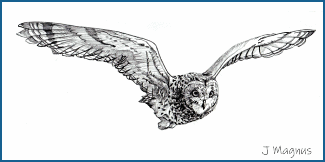
Denhall Quay: What's owl the fuss about?
Dan
Trotman RSPB Jan 2022
As we regularly talk about, our Dee Estuary reserve is vast, covering
more than 6500 hectares of tidal habitats stretching 14 miles along the
Welsh shore from Oakenholt to Talacre, and six miles on the English
side from Burton to Gayton. However, apart from the three recognised
sites of Burton Mere Wetlands, Parkgate and Point of Ayr, the rest of
the reserve is a mystery to many, with little signage or interpretation
to help the public understand and enjoy the landscape and wildlife.
Owing to easy access not far from Burton Mere Wetlands, Burton Marsh is
an increasingly well known area. Becoming part of the reserve with our
purchase of Burton Marsh Farm in 2006, it spans from Burton Point all
the way to Neston Old Quay at the south end of Neston Reedbed. Nestled
roughly halfway between Burton Mere Wetlands and Parkgate, adjacent to
The Harp Inn and with access from the Burton Marsh Greenway sits
Denhall Quay, a derelict sandstone jetty with an important place in the
Dee's history before the dramatic changes initiated by the canalisation
in the 1730s.
It has long been a popular place for local birders, protruding into the
marsh so offering unrivaled panoramic views from Burton Point to
Neston Reedbed, perfect for scouring the landscape in winter for birds
of prey as well as huge flocks of waders and wildfowl to whom the
estuary is a priceless winter refuge. Like all wildlife, birds are
driven by where they can find food, and this winter the saltmarsh
around Denhall Quay has become a prime location for short-eared owls to
hunt, simultaneously offering superb views for birdwatchers and
wildlife lovers.
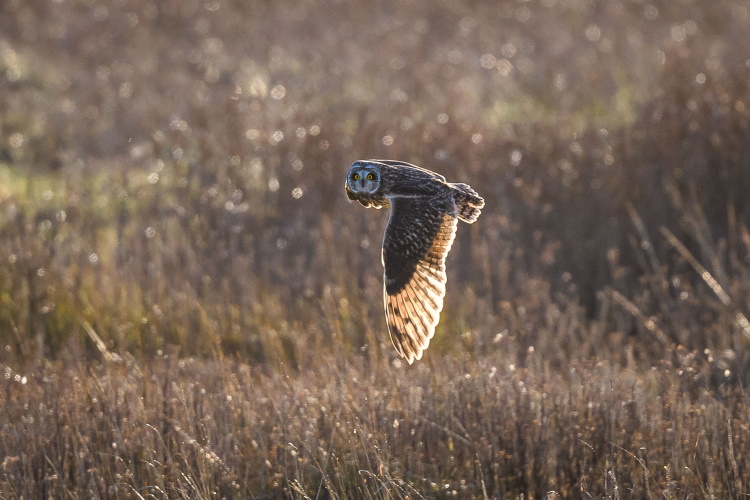
Short-eared owl (Paul Jubb)
These enigmatic birds are an annual winter resident on the saltmarsh,
but are rarely seen as close and reliably as has been the case for the
past few weeks. Often, they are the sought after highlight of a famous
spring high tide at Parkgate. As word of mouth spread of their daily
displays, the number of people visiting Denhall Quay grew to
unprecedented levels particularly during the fair weather around
Christmas and New Year, and sadly a minority of these were straying
onto the marsh in front of The Harp in an effort to get closer views or
photographs of the owls. In doing so, new "paths" were being forged in
pristine saltmarsh, an emerging reedbed was being trampled, and the
owls were being prevented from hunting this area due to the presence of
people in their favoured spot.
Clearly this is not responsible wildlife watching, and as stated in the
birdwatchers' code, the birds' interests should
always come first. Similarly, the nature photographers' code of practice has one
underpinning rule of "the welfare of
the subject is more important than the photograph".
As well as forcing the owls to hunt further afield on the estuary -
where the small mammal availability may be lower - resulting in
disappointment and frustration for those watching respectfully from
Denhall Quay or the marsh edge, encroachment on the marsh also causes
disturbance to the waders and ducks resting or feeding on the pools of
this inner marsh area. These, ultimately, are the primary reason for
the RSPB protecting the expanse of saltmarsh and mudflat that we do on
the reserve; the Dee Estuary is the third most important estuary in the
UK for waterbirds, supporting over 100,000 of them through the winter
months.
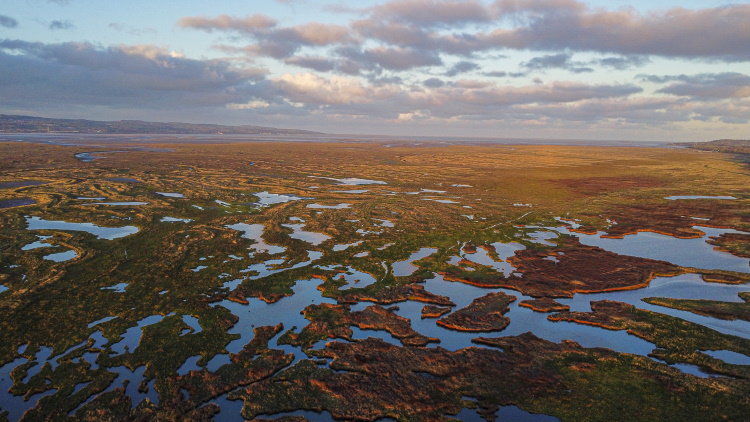
Drone photo showing the myriad pools on the saltmarsh (Josh Robertson)
In the first week of January, we began to address the issue by
installing signs asking people not to enter the sensitive parts of the
marsh that had been causing problems. The reserve team have also been
monitoring the site as much as capacity allows. Thankfully, the issue
seems to already be easing, helped also by the amount of public support
on social media calling out the inappropriate behaviour.
Some people may wonder what all the fuss is about, and what harm it
causes if the birds fly away to another part of the marsh. As mentioned
above, the owls' location indicates a prevalence of food, and being
forced to hunt elsewhere means they may struggle to find sufficient
food to survive the winter. Similarly, the ducks and waders being
scared from this area have settled there due to the right food in the
water or mud, or to rest away from the rising tide on the outer part of
the saltmarsh.
Some of these birds have migrated thousands of miles and will have lost
half of their body weight in doing so. It is essential for them to feed
and rest sufficiently over winter to regain this weight and return to
prime condition ready to migrate north to their breeding grounds in
spring. Disturbing birds does more than simply cause them to fly away;
it uses up their energy reserves, decreasing their chance of survival.
Once frightened away, birds can take a long time to settle and they
remain alert, meaning they cannot rest properly for a while afterwards.

Pink-footed geese migrate from Iceland and Greenland to overwinter on the Dee Estuary in their thousands (Paul Jubb)
In an ideal world, nobody would walk onto the saltmarsh at Denhall
Quay, or any part of the estuary, to keep human disturbance to the
birds at a minimum. However, a permissive route exists, forming a loop
between Denhall Quay and the car parking area at the end of Marshlands
Road. This dates back generations, long before the area was purchased
by the RSPB in 2006. There is no public right of way onto the marsh,
and the historic access was intended for the local residents between
Burton and Neston.
Over time, the area has become increasingly used by people from further
afield, and due to Covid lockdowns over the past two years, has at
times been incredibly busy. We have observed the negative impact on the
birds using this part of the reserve, although it is encouraging that
the short-eared owls this winter are happily hunting within the loop,
when not deterred by people straying from the long-standing route.
This route is regularly referred to as the "dog-walkers' loop" which
reflects its most frequent use, and whilst dogs and wildlife -
especially wetland birds that feed and roost on the ground - do not mix
well, dogs kept on leads or at heel here should cause little
disturbance to birds on pools in the proximity. Sadly, it is not
uncommon for dogs to chase and flush flocks of waterfowl from the
marsh, an obvious disturbance issue that we are keen to address in the
near future to give these overwintering flocks the protection they need.
Aside from the RSPB's objective of managing a huge area as a nature
reserve, the entire Dee Estuary has extensive legal protections for its
wildlife; as a Special Protection Area (SPA), a Site of Special
Scientific Interest (SSSI) - both for the winter bird populations - and
the saltmarsh is a Special Area of Conservation (SAC) habitat. This
demonstrates how important the Dee Estuary is, not only on a national
level but on a European scale, and reinforces the need for us all to
behave in a way that is sensitive to nature rather than just to suit
our own desires.
There really is no need to venture onto the saltmarsh from Denhall
Quay, to enjoy the short-eared owls or any of the other brilliant birds
that the estuary supports. The slight height of the Quay gives an
advantage to see further across the marsh; with patience and effort,
you can see flocks of pink-footed geese, wigeon, teal, lapwing,
redshank and curlew to name just a few, not to mention the long list of
birds of prey, egrets and herons, and characterful songbirds like
stonechat and skylark.
Since we do not live in an ideal world, it is worth highlighting that
the area of saltmarsh affected by the permissive route is a small
fraction of our reserve. Although we would prefer to avoid any
disturbance to the pools on the inner marsh around Denhall Quay, there
is at least a natural saltmarsh gutter which creates a clear boundary
to restrict access to the rest of the marsh. If you happen to see
anybody beyond there, it could be RSPB staff or volunteers, our tenant
farmer or his shepherds, or a member of the Dee Wildfowlers' Club.
Although it looks as though the new signs are being effective,
directing people away from the recently disturbed and trampled areas
where we do not want a new path formed to prevent long-term damage to
the saltmarsh and birds, we will continue to monitor the area over the
coming weeks. All that we ask is if you choose to visit the estuary,
please follow the Countryside Code
to help us in our efforts to protect some of Europe's most threatened
landscapes and wildlife. Wildlife doesn't have a choice of going
elsewhere.
Dan
Trotman RSPB Jan 2022 (First published on the RSPB Dee Estuary Blog on 12 Jan 2022 - see
https://community.rspb.org.uk/placestovisit/deeestuary/b/deeestuary-blog)
Colour Ring Report
Bar-tailed Godwit
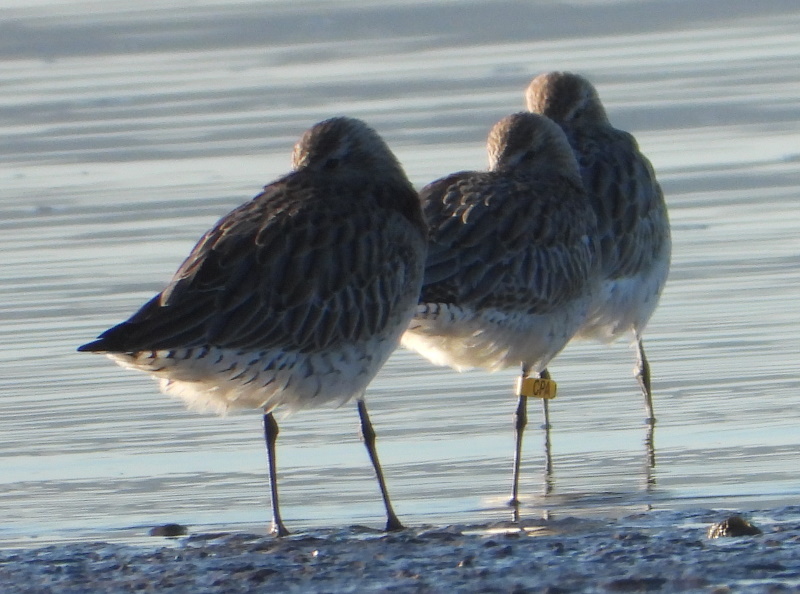
Although regular on the Dee Estuary and North Wirral we only get small numbers here, perhaps two or three hundred and consequently colour ringed birds are rare. This one, ringed in Norway, is only the fourth colour-ringed Bar-tailed Godwit in our database.
Yellow flag (CPA)
Ringed at Kragero, Telemark, southern Norway, on 16/08/2021.
Recorded:
Seaforth NR on 18/12/2021
Birkdale on 05/01/2022
Thurstaston on 13/01/2022
Black-tailed Godwit
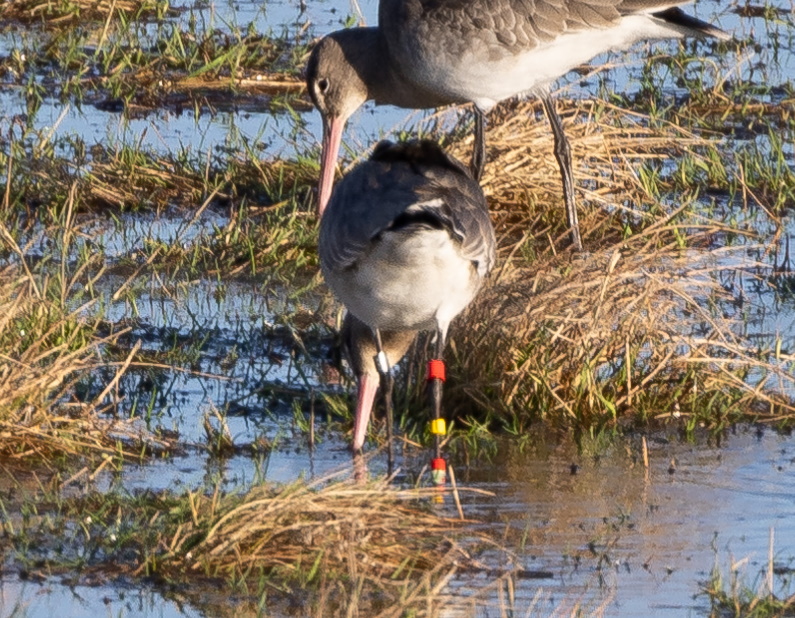
We know from colour ringing that waders, and in
particular Black-tailed Godwits, tend to have a set routine and are
very site faithful using the same migration routes, moulting areas and
wintering sites year after year. But occasionally you get one
which is in the 'wrong' place and you wonder what the hell it's doing
there! Such is the case with R//YRL pictured above.
R//YRL
Ringed by the Andurina ringing group at Pontevedra (near Vigo) in NW
Spain on 23/12/2019 as an adult.
On the assumption it bred in Iceland the following year (2020) it
returned early being seen at Woolston Eyes on 24/06/2020. It next
turned up at the Caldy Wildfowl Collection where it stayed (with
another
Andurina ringed bird) all July and the first half of August, last
recorded on the Dee Estuary at Connah's Quay on 20/08/2020.
That October (still 2020) it was again recorded in NW Spain as you
would expect for a bird which winters in Spain (or so we thought
judging from when and where it was ringed). But it then disappeared for
well over a year before turning up at RSPB Marshside, Southport, on
05/01/2022 - a somewhat unexpected location for a bird thought to be at
least 800 miles to the south!
Grey Plover
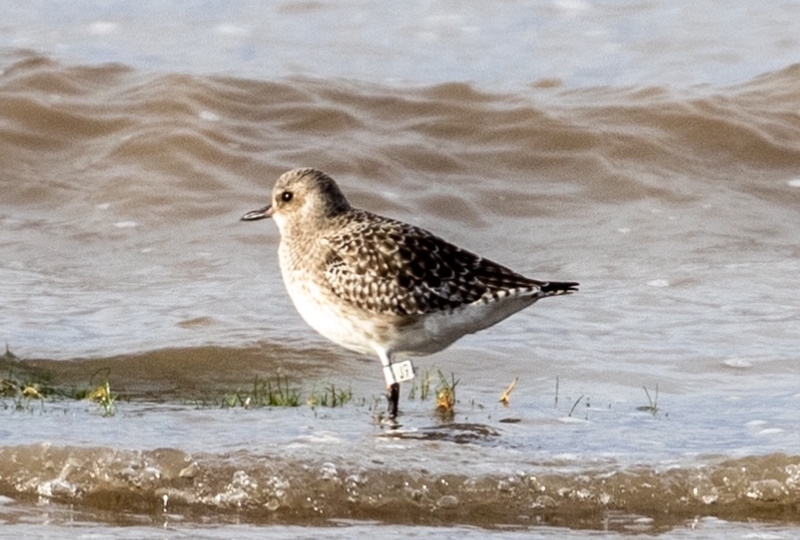
Grey Plover White Flag (J9) is
our first of this species we've recorded which was ringed by the Wash
Wader Ringing
Group.
Ringed at Terrington Marsh (The Wash) on 03/09/2019.
Recorded:
Birkdale on 30/03/2021.
Hoylake on 06/01/2022.
Redshank
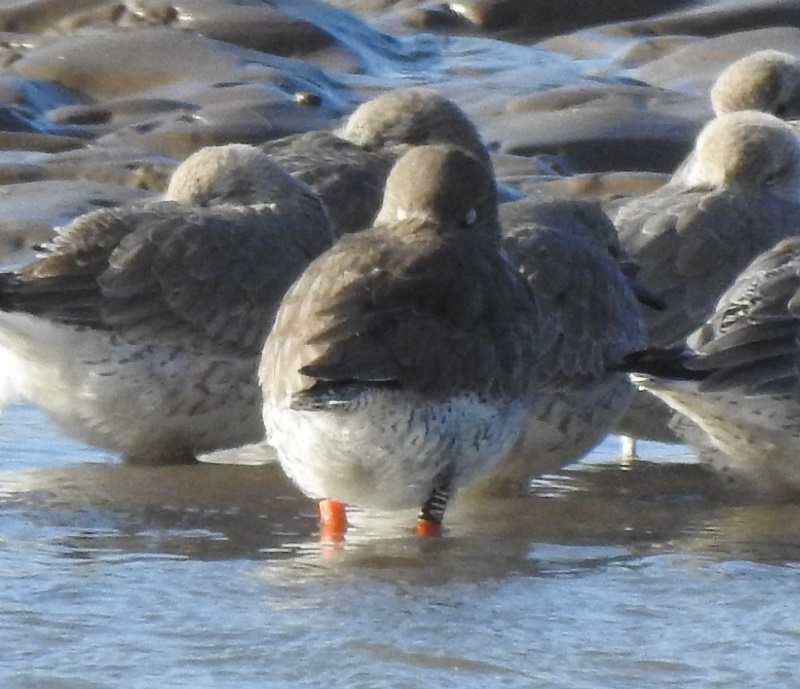
Despite
having some of the largest numbers of Redshanks in the country
we see very few with rings so it was good to see this one ringed by the
Mid-Wales Ringing Group.
O - N(AUC)
Ringed at Ynyslas, near Borth on Cardigan Bay, mid-Wales on
16/12/2020.
Recorded at Thurstaston on 27/01/2022.
Colour Rings were recorded by Richard Smith, Steve Hinde, Matt Thomas, Peter Sutton, Eddie Williams, John Jakeman, Sean O'Hara and Steve Williams.
January Bird News
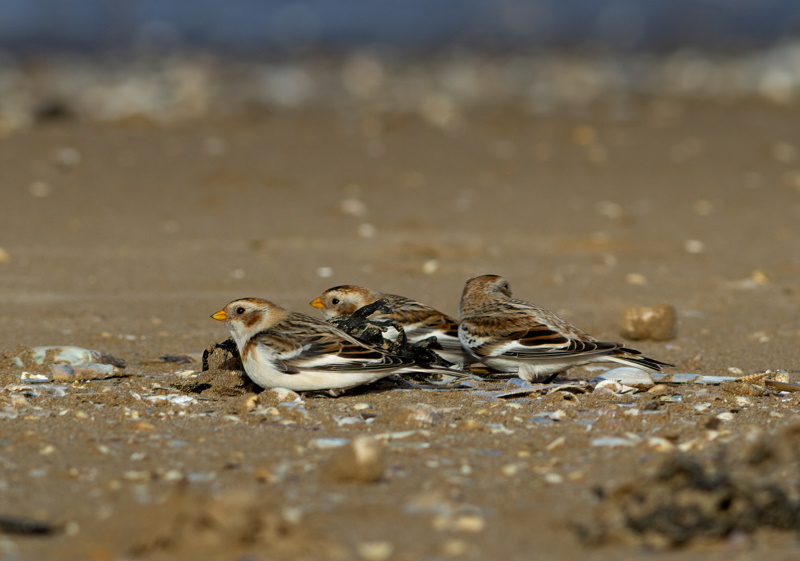
As per the above article we continued to have
problems with people going onto the marsh at Neston trying to
photograph Short-eared Owls and I stopped reporting records from there
as a result - so apologies for all those that sent me their sightings
and wondered why they were ignored. It wasn't just the number of people
out on the marsh which angered us it was the behaviour of a small
majority which were seen, and filmed, deliberately
flushing the birds, waving their arms and running towards them!
Anyway, despite all this we had some good views of Short-eared Owls and
I think the peak count was seven from Denhall Quay early in the month,
with four recorded at Parkgate on the 5th during the spring tide.
There seems to have been at least seven Snow
Buntings in the area with singles at Point of Ayr and Hoylake, and five
on Wallasey shore/dunes for most of the month. There has been a big
influx of Bramblings into the country this winter and we had our share
with at least 20 in a large flock of Chaffinches at Thornton Hough with
a couple of Yellowhammers in the area as well. A much rarer finch was
recorded with a flyover of a Corn Bunting at Riverbank Road, Heswall,
on the 27th and another Yellowhammer was also recorded there.
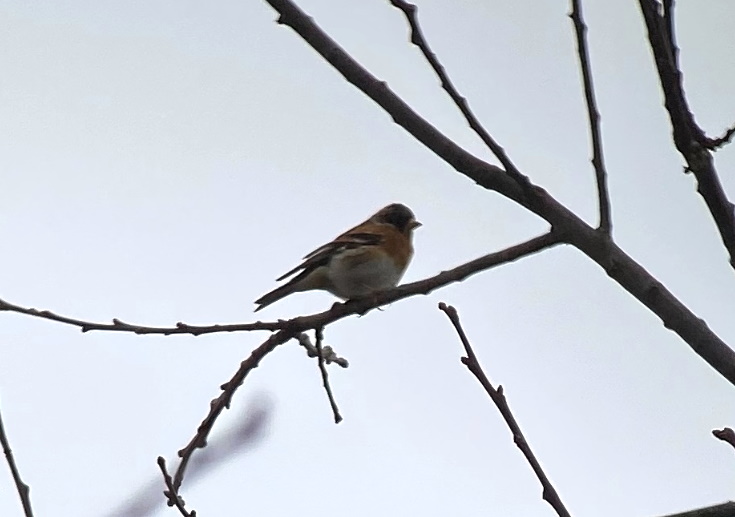
We had some very variable weather in January including gales and rain
but we also had a week of glorious sunny weather with little wind
around mid-month and consequently it was fantastic being out doing some
birding. Simon King was at Meols and Thurstaston that week filming
Peregrines hunting the Knot flocks and I understand got some great
footage. I was at Thurstaston on the 13th when there were spectacular
views of
the knots swirling around over the sand banks. I'm not sure about total
numbers but there must have been at least 20,000 on Dawpool Bank and
10,000 at Meols on the 24th was a very high count for that site.
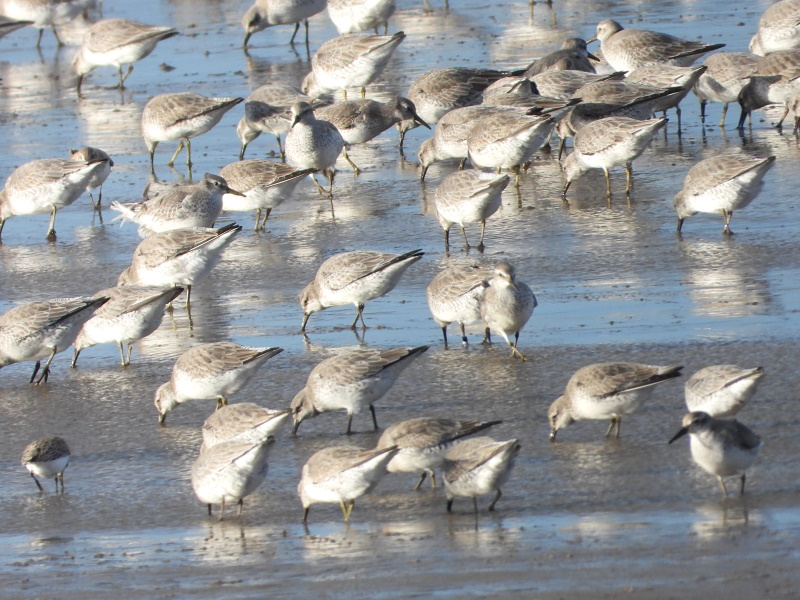
The flocks were often on the mud just below Meols Promenade giving wonderful views
Neston Reedbed is always worth a look just before dusk with a Bittern
and over 10 Marsh Harriers flying into roost, and somebody had a
probable roost of at least 10 Water Pipits there although poor light
made it impossible to be 100% sure of the ID.
21 Red-breasted Mergansers was a good count on the sea at high tide at
Heswall on the 23rd. Goosanders reached 13 on West Kirby Marine Lake
but they were also spotted on various ponds around the area, including
four on Gilroy Duck Pond. At the end of the month 5,000 Pink-footed
Geese flew north leaving the estuary at first light, an amazing sight.
I suspect there must be a lot of interchange between North Norfolk, the
Dee Estuary and Martin Mere (South Lancs) through the winter, and we
also know many thousands move at night.
Shotwick Boating Lake had a Long-tailed Duck, a Great Northern Diver
and about 40 Little Grebes early in the month.
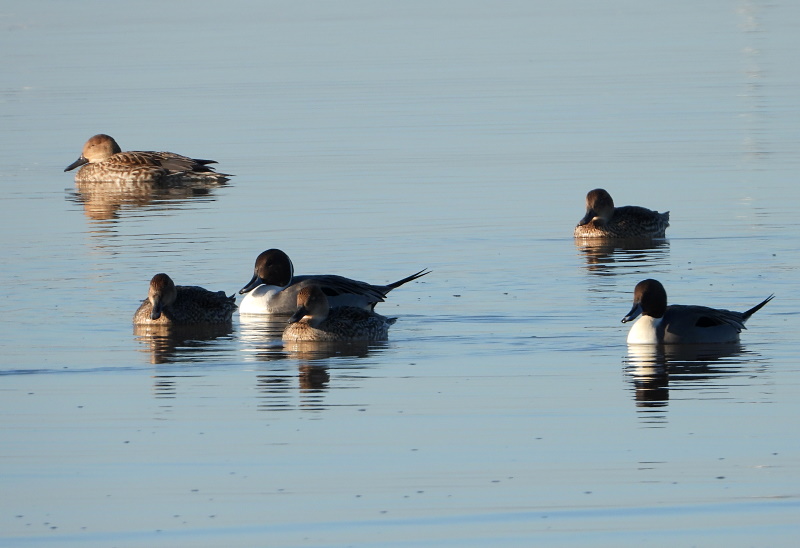
What to expect in February
February is unpredictable - over the past few years
we've had weather more like May, bitterly cold spells and at least one
strong gale. Obviously the weather has a big effect on what we will see!
The month starts with three spring high tides, they are not massive
tides but a fresh westerly should bring the sea up to Heswall and
Parkgate with spectacular views of Short-eared Owls, Harriers and
masses of geese, ducks and waders. Hoylake Shore may well be worth a
visit to see the high tide wader roost.
If we get some calm weather then a look out to sea will be worthwhile -
you will see hundreds of Great Crested Grebes and thousands of Common
Scoters, and we often see Velvet Scoters, Eiders, Goldeneyes, Scaup and
a Long-tailed Duck or two. Look out from Meols, Hoylake, Red Rocks,
Hilbre or Point of Ayr.
There will be signs of spring including the arrival of Avocets at
Burton Mere Wetlands which could reach as many as 50 by the month-end.
Look out also for Mediterranean Gulls starting to turn into summer
plumage. A Stonechat passage is often seen along the coast this month.
If we get a spell of warmer weather towards the end of the month then
we could see an early migrant, one or two Sand Martins, Wheatears and
White Wagtail have all been recorded in February in recent years.
Top of Page
Forthcoming Events
February Highest Spring Tides (Liverpool)
Also see Tides page.
2nd February, 11.54hrs (GMT), 9.8m.
3rd February, 12.37hrs (GMT), 9.8m.
4th February, 13.18hrs (GMT), 9.7m.